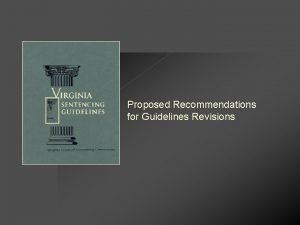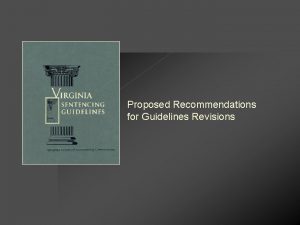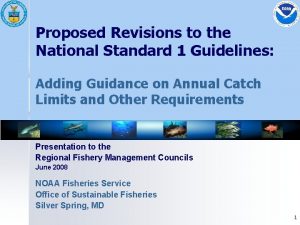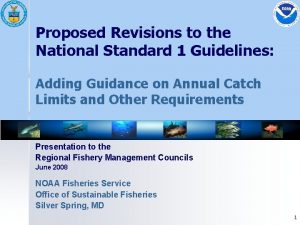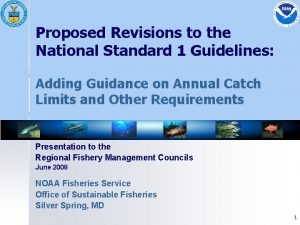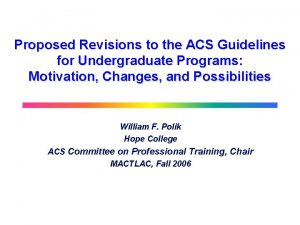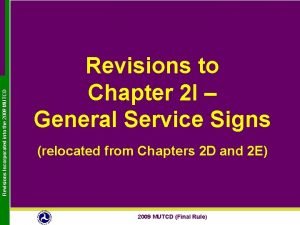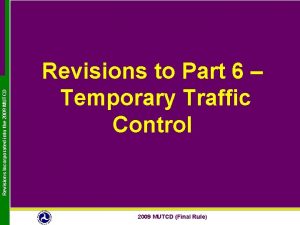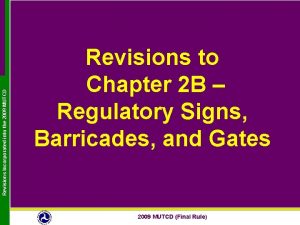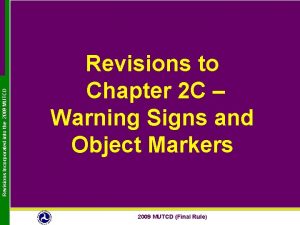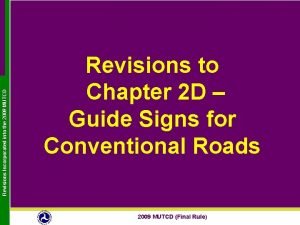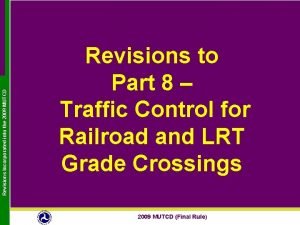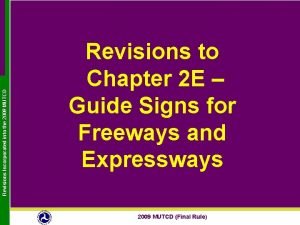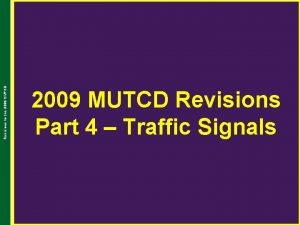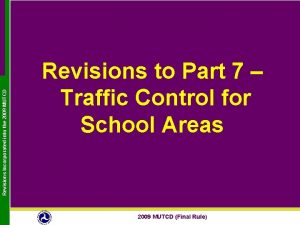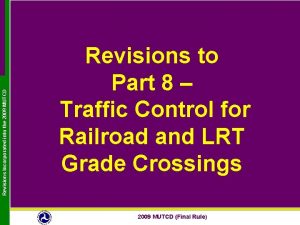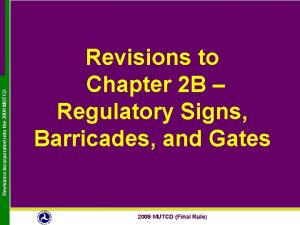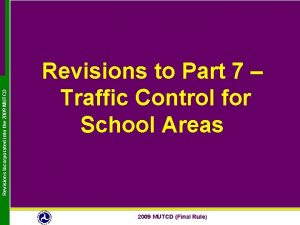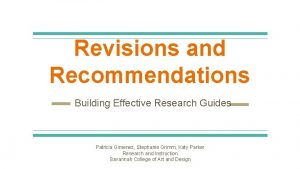Proposed Recommendations for Guidelines Revisions Proposed Recommendations At




























- Slides: 28

Proposed Recommendations for Guidelines Revisions

Proposed Recommendations § At its September meeting, the Commission considered proposals for possible revisions to the sentencing guidelines. § The Commission voted to table two recommendations pending further analysis by staff. § Staff have conducted additional analysis for the Commission’s review. 2

Proposed Recommendation 3: False Statement on Firearm Consent Form 3

False Statement on a Firearm Consent Form, § 18. 2 -308. 2: 2(K) § Issue • This offense was added to the guidelines effective July 1, 2006. • During the first year of implementation, compliance for Making a False Statement on a Firearm Consent Form was 67%, with mitigation comprising nearly all of the departures (30%). • • Most commonly cited reasons for mitigation are: minimal circumstances of the case, plea agreement, lack of serious prior record, and recommendation of Commonwealth’s attorney. Many of the offenders whose sentences were mitigated had only one count of the offense, no additional offenses, and no victim injury; many had a prior record that included a previous incarceration, but no legal restraint was scored. 4

False Statement on a Firearm Consent Form, § 18. 2 -308. 2: 2(K) Actual Disposition Recommended Disposition Probation/ No Incarceration 1 day - 6 mos. Incarceration over 6 months Probation/ No Incarceration 79. 3% 20. 7% 0% 29 cases Incarceration over 6 months 36. 8% 26. 3% 36. 8% 38 cases 5

Proposed Recommendation 3 – Original 3 6

Proposed Recommendation 3 – Original • By revising the primary offense score for Making a False Statement on a Firearm Consent Form on Section A of the Weapons Guidelines from 4 points to 3 points, compliance can be improved slightly. FY 2007 (66 cases) Current Guidelines Original Proposal Compliance 67% 70% Mitigation 30% 24% 3% 6% Aggravation 7

Virginia Form 8

Federal Form 9

Denial of Firearm Purchases • The State Police maintains files on all firearm transaction requests and the results of the state and federal criminal history searches, as well as searches for protective orders, outstanding warrants, and adjudications of mental deficiency. • • Records are kept for approximately 12 months and then destroyed. Commission staff requested copies of these records for persons convicted of making a false statement in order to gain a better understanding of these cases. 10

Basis of Firearm Transaction Denial For 8 of these offenders, a juvenile adjudication for a felony offense was noted. For 10 of these offenders, an out-of-state felony conviction was noted. Note: Firearm transaction records were available for 61 of the 70 offenders examined. Multiple reasons may be cited in each case. 11

Basis of Firearm Transaction Denial and Guidelines Compliance Felony Conviction or Juvenile Adjudication( N=30) Domestic Violence Conviction (N=20) Protective Order (N=8) Felony Indictment, Warrant or Mental Health (N=6) Compliance 60% 75% 100% Mitigation 40% 25% 12. 5% 0% 0% 5% 12. 5% 0% Aggravation Note: Firearm transaction records were available for 61 of the 70 offenders examined. Multiple reasons may be cited in each case. 12

Basis of Firearm Transaction Denial and Guidelines Compliance Offenders with a Prior Felony Conviction or Juvenile Adjudication No Prior Felony Person Crime (N=22) Prior Felony Person Crime (N=8) Compliance 55% 75% Mitigation 45% 25% 0% 0% Aggravation Note: Firearm transaction records were available for 61 of the 70 offenders examined. Multiple reasons may be cited in each case. 13

Time Since Prior Felony Conviction or Juvenile Adjudication within Last 4 Years (N=16) Prior Felony Conviction or Juvenile Adjudication More than 4 Years Ago (N=14) Compliance 75% 43% Mitigation 25% 57% Aggravation 0% 0% Note: Firearm transaction records were available for 61 of the 70 offenders examined. Multiple reasons may be cited in each case. 14

Proposed Recommendation 3 – Revised Revise the Weapons Sentencing Guidelines by decreasing the points assigned to the primary offense factor on Section A (from 4 points to 1) and by adding a factor to increase the score (by 3 points) for offenders with: - a prior adult or juvenile felony conviction for a crime against the person - a conviction for any other felony within the last five years - a prior domestic assault misdemeanor conviction - an outstanding protective order For offenders meeting any of the above conditions, the revision will have no impact on guidelines recommendation. For the remaining offenders, the guidelines will be less likely to recommend a term of incarceration of more than six months. 15

1 O CT W NE FA R SCORE THE FOLLOWING ONLY IF PRIMARY OFFENSE AT CONVICTION IS FALSE STATEMENT ON A FIREARM CONSENT FORM (§ 18. 2 -308. 2: 2(K)) Basis of False Statement on Consent Form (listed below) If YES, add 3 Prior felony conviction for crime against person Other prior felony conviction within 4 years of current offense Prior domestic assault misdemeanor conviction Subject to protective order at time of offense 16

Proposed Recommendation 3 – Revised § By revising the guidelines for Making a False Statement on a Firearm Consent Form as described, compliance can be improved slightly and a better balance between mitigation and aggravation can be achieved. Current Guidelines Original Proposal Revised Proposal Compliance 67% 70% Mitigation 30% 24% 17% 3% 6% 13% Aggravation 17

Proposed Recommendation 4: Involuntary Manslaughter 18

Involuntary Manslaughter (§ 18. 2 -36 & § 18. 2 -36. 1(A)) § Issue • Combined, the compliance for Involuntary Manslaughter and Involuntary Vehicular Manslaughter is 52%, with nearly all of the departure sentences above the guidelines. • • Most commonly cited reasons for aggravation are: aggravating circumstances/flagrancy of offense, extreme violence/victim injury, guidelines recommendation is too low, offender has drug/alcohol problems In nearly two-thirds of the aggravating departure cases, the offender had been recommended for probation or up to six months in jail but was sentenced to serve more than six months of incarceration. 19

Involuntary Manslaughter (§ 18. 2 -36 & § 18. 2 -36. 1(A)) Compliance in Cases of Involuntary Manslaughter and Involuntary Vehicular Manslaughter FY 2003 – FY 2006 224 cases 20

Involuntary Manslaughter (§ 18. 2 -36 & § 18. 2 -36. 1(A)) Actual Disposition Recommended Disposition Probation/ Incarceration up to 6 months Incarceration over 6 months Probation/ Incarceration up to 6 months 38. 2% 61. 8% 102 cases Incarceration over 6 months 7. 4% 92. 6% 122 cases 21

Proposed Recommendation 4 – Original 3 2 nd count 22

Proposed Recommendation 4 – Original § By increasing the points for the primary offense on Section A of the Murder/Homicide Guidelines from 1 point to 3 points (for 1 count) and from 3 to 8 points (for 2 counts), the guidelines would better reflect recent judicial practice. Compliance Mitigation Aggravation Current Guidelines Proposed Change 52% 62% 7% 7% 41% 31% 23

Involuntary Manslaughter (§ 18. 2 -36 & § 18. 2 -36. 1(A)) Recommended Disposition Compliance Mitigation Aggravation Probation/ Incarceration up to 6 months 38. 2% 0% 61. 8% 102 cases Incarceration over 6 months 63. 9% 10. 7% 25. 4% 122 cases 24

Proposed Recommendation 4 – Revised Revise the Murder/Homicide Sentencing Guidelines applicable to Involuntary Manslaughter by: - increasing the points for the primary offense on Section A from 1 point to 3 points (for 1 count) and from 3 to 8 points (for 2 counts), and - increasing the points for the primary offense on Section C (adding 3 points for the Other Category, and making corresponding increases for Category I and Category II). As a result of these changes, offenders convicted of involuntary manslaughter will be more likely to receive a recommendation for more than six months of incarceration. In addition, offenders convicted of involuntary manslaughter will receive a longer sentence recommendation on Section C. 25

Proposed Recommendation 4 – Revised 88 X 44 X 22 X 26

Proposed Recommendation 4 – Revised § By revising the guidelines for Involuntary Manslaughter in the manner described, compliance can be improved and the rate of aggravation can be reduced, better reflecting recent judicial practice. Compliance Mitigation Aggravation Current Guidelines Original Proposal Revised Proposal 52% 64% 7% 7% 8% 41% 31% 28% 27

28
 Varför kallas perioden 1918-1939 för mellankrigstiden
Varför kallas perioden 1918-1939 för mellankrigstiden Tack för att ni har lyssnat
Tack för att ni har lyssnat Rutin för avvikelsehantering
Rutin för avvikelsehantering Klassificeringsstruktur för kommunala verksamheter
Klassificeringsstruktur för kommunala verksamheter Vad är vanlig celldelning
Vad är vanlig celldelning Myndigheten för delaktighet
Myndigheten för delaktighet Fuktmätningar i betong enlig rbk
Fuktmätningar i betong enlig rbk Påbyggnader för flakfordon
Påbyggnader för flakfordon Var 1721 för stormaktssverige
Var 1721 för stormaktssverige Tack för att ni har lyssnat
Tack för att ni har lyssnat A gastrica
A gastrica Referatmarkeringar
Referatmarkeringar Byggprocessen steg för steg
Byggprocessen steg för steg Typiska drag för en novell
Typiska drag för en novell Presentera för publik crossboss
Presentera för publik crossboss Punkthöjd karttecken
Punkthöjd karttecken Mindre än tecken
Mindre än tecken Elektronik för barn
Elektronik för barn Debattartikel struktur
Debattartikel struktur Toppslätskivling dos
Toppslätskivling dos En lathund för arbete med kontinuitetshantering
En lathund för arbete med kontinuitetshantering Borra hål för knoppar
Borra hål för knoppar Mjälthilus
Mjälthilus Bris för vuxna
Bris för vuxna Smärtskolan kunskap för livet
Smärtskolan kunskap för livet Tryck formel
Tryck formel Trög för kemist
Trög för kemist Etik och ledarskap etisk kod för chefer
Etik och ledarskap etisk kod för chefer Indikation för kejsarsnitt på moderns önskan
Indikation för kejsarsnitt på moderns önskan





























